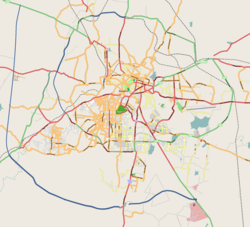Ulsoor
|
Ulsoor ಹಲಸೂರು Halasuru |
|
|---|---|
| neighbourhood | |
| Coordinates: 12°58′N 77°38′E / 12.97°N 77.63°ECoordinates: 12°58′N 77°38′E / 12.97°N 77.63°E | |
| Country | India |
| State | Karnataka |
| Metro | Bangalore |
| Languages | |
| • Official | Kannada |
| Time zone | IST (UTC+5:30) |
| Vehicle registration | KA-03 |
Ulsoor, or Halasuru (Kannada: ಹಲಸೂರು), is one of the oldest neighbourhoods in the city of Bangalore. It is located in central Bangalore, and begins roughly near the eastern terminus of MG Road. It is renowned for its numerous temples and rather narrow streets.
The village of Bangalore is said to have been gifted to Kempe Gowda I (1513–1569), the founder of Bangalore, by the Vijayanagar emperors. The Ulsoor Lake was built by his successor, Kempe Gowda II, and is the only surviving tank built by the Gowda kings in Bangalore. The first British military station was set up in Halasuru in 1807.
There used to be a jackfruit orchard near the Ulsoor Lake, and the Kannada name for jackfruit being 'Halasina Hannu', the area came to be known as Halasuru. During the British rule, the name was anglicised to 'Ulsoor'.
The population of Ulsoor consists of local Kannada speaking population. It is also largely dominated by Tamils.
The Ulsoor Lake is one of the biggest lakes in Bangalore.
There are several old temples in Ulsoor, which are scattered throughout the area. The oldest temple is the Halasuru Someshwara Temple, was built by Kempe Gowda I in the 16th century and is a mixture of Hoysala, Chola and Vijayanagara architecture.
Sri Subrahmanya Temple, Halasuru, which is more than 800 years old, is also a prominent temple.
The largest Sikh shrine in Bangalore, the Sri Guru Singh Sabha, is situated on the banks of the Ulsoor Lake. The sprawling white building on the edges of the lake, is indeed a well known place on the City's landscape. Sri Guru Singh Sabha Gurudwara at Ulsoor was built in 1943 by A G Russell and was inaugurated in 1945. "While the Jollys and the Sahani families were the main forces behind the construction of the Gurudwara, all the community members and the Kohli and Chandoks families financed it under the leadership of Ahulwalia and the Gill family from the neighboring Haudin Road Sikh foundation. It was only later in 1975, that the first floor of the Gurudwara was built. The monument is known for its splendid structure - it has added to the beauty of the area and Kensington Road where it is situated, which is also popularly known as Gurudwara Road. Being the biggest Gurudwara in City, a huge gathering of Sikhs come here on Wednesdays for prayer and the 'langar' on Sundays. All the devotees are offered free meals on Sundays, in what is known as the 'Langar Sewa'. Around 1000 people visit the Gurudwara on Sunday mornings, while more than 2,000-3000 people visit in the afternoon and seek blessings post blessings they have Guru Ka Langar(Meals).
...
Wikipedia

